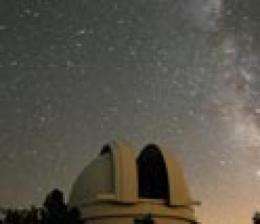Palomar Observatory is last stop on 24-hour webcast linking telescopes around the globe and in space

Around the World in 80 Telescopes, part of the International Year of Astronomy's 100 Hours of Astronomy Cornerstone Project of global outreach activities, will begin on April 3. Observatories in 15 countries spanning all the continents, as well as 11 observatories in space, will participate in this 24-hour trip to observatories across the globe and in the so-called final frontier.
The last stop of this journey will be the Palomar Observatory, run by the California Institute of Technology. There, astronomers using Palomar's 200-inch Hale Telescope will be on hand to answer questions and explain their research. Palomar Observatory's participation is made possible through its high-speed data connection provided by the High Performance Wireless Research and Education Network (HPWREN), sponsored by the National Science Foundation.
HPWREN provides 155 megabits per second (OC-3 capacity) terrestrial microwave links that network Palomar Observatory to the rest of the world. This high-speed connectivity is essential for current and future research programs at Palomar, and also provides the necessary bandwidth to allow for this and other live broadcasts to take place from the observatory.
"It's important for the public to see that complex astronomical research is done by real people and how real astronomical research takes place. HPWREN's high speed connection enables us to take to the public the story of what we do at Palomar," said Palomar Observatory Spokesman W. Scott Kardel.
"It is incredibly exciting to see the NSF-funded HPWREN cyberinfrastructure show so many interdisciplinary and multi-institutional research and education results," says Hans-Werner Braun, principal investigator of the HPWREN project. "In particular, many activities over the years from researchers at the Palomar Observatory, with the science data utilizing HPWREN, have produced first-class outcomes."
The live webcast will begin on April 3, 2009, at 2:00 a.m. Pacific Standard Time with the telescopes on Mauna Kea in Hawaii before moving westwards around the planet. The event ends on April 4, 2009, 2:00 a.m. Pacific Standard Time. Palomar Observatory's portion of the event is scheduled to begin at 1:40 a.m. on April 4. The live video webcast will be available on the 100 Hours of Astronomy Web site at http://www.100hoursofastronomy.org/.
In honor of the 400th anniversary of Galileo first using his astronomical telescope, 2009 has been designated as the International Year of Astronomy. 100 Hours of Astronomy is a global star party that is a cornerstone event of this year-long celebration of astronomy.
Source: National Science Foundation
















